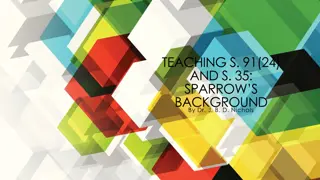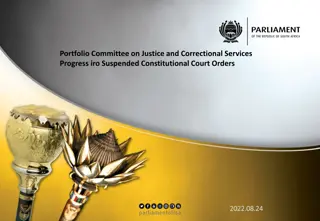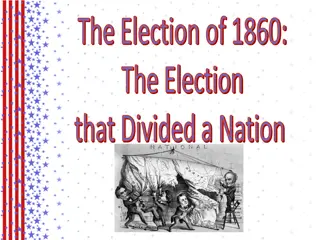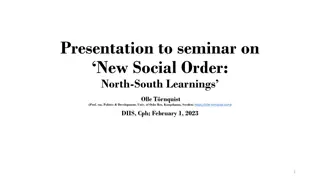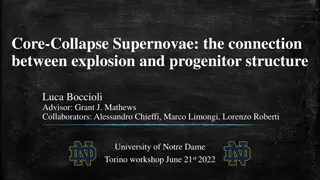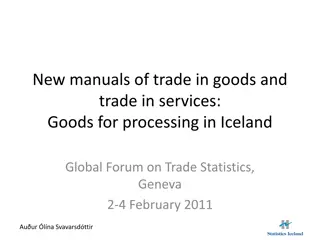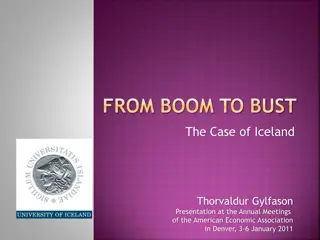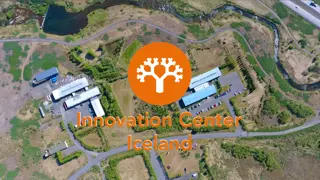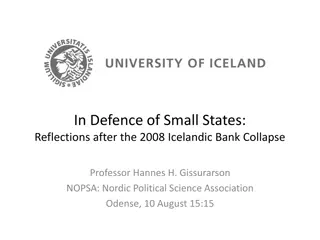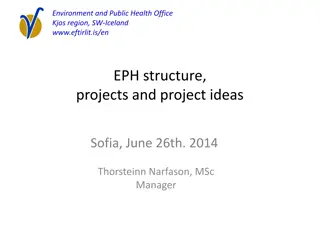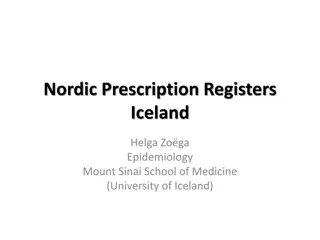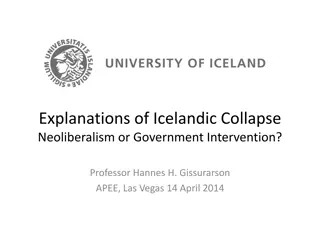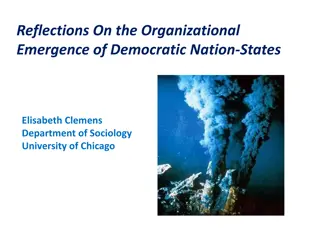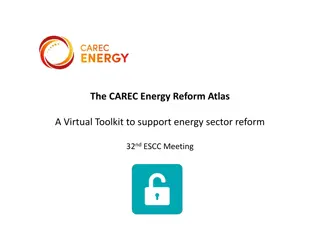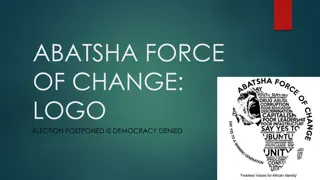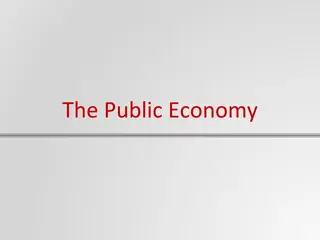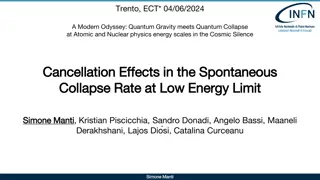Iceland's Constitutional Journey: From Economic Collapse to Democratic Reform
Iceland faced a unique situation post the 2008 economic collapse, responding with an IMF-supported rescue, financial fraud prosecutions, and a constitutional reform movement. Despite challenges, strong popular support and civic pressure pushed for political accountability and a new constitution, reflecting Iceland's quest for democratic renewal and citizen empowerment.
Download Presentation

Please find below an Image/Link to download the presentation.
The content on the website is provided AS IS for your information and personal use only. It may not be sold, licensed, or shared on other websites without obtaining consent from the author.If you encounter any issues during the download, it is possible that the publisher has removed the file from their server.
You are allowed to download the files provided on this website for personal or commercial use, subject to the condition that they are used lawfully. All files are the property of their respective owners.
The content on the website is provided AS IS for your information and personal use only. It may not be sold, licensed, or shared on other websites without obtaining consent from the author.
E N D
Presentation Transcript
Constitution on Ice Thorvaldur Gylfason
Overview First-world economy, third-world politics Decaying social capital, low trust, etc. Iceland s response to 2008 collapse IMF-supported rescue operation went well Prosecutions of financial fraud underway Constitutional reform held hostage Strong popular support in 2012 referendum followed by overt political attempts to thwart the will of the voters
Income per person and per hour (Current international $, ppp) GNI per capita 1990-2013 GNI per hour worked 1990-2013 70000 80 70 60000 60 50000 50 40000 40 30000 30 20000 20 10000 10 0 0 Denmark Finland Iceland Denmark Finland Iceland Norway Sweden Norway Sweden Source: World Bank World Development Indicators and The Conference Board Total Economy Database , January 2013, http://www.conference-board.org/data/economydatabase/.
Corruption 2012 Business corruption Political corruption 100 80 90 70 80 60 70 50 60 50 40 40 30 30 20 20 10 10 0 0 Source: Gallup, Source: Transparency International. http://www.gallup.com/poll/165476/government- corruption-viewed-pervasive-worldwide.aspx.
Interpersonal trust and trust in institutions Trust in other people Iceland: Trust in institutions 2013 160 90 80 140 70 120 60 50 100 40 80 30 20 60 10 40 0 20 0 Iceland 1999 Finland 2005 Denmark 1999 Sweden 2006 Norway 2007 Source: World Values Survey. Source: Capacent (Gallup).
Constitutional Reform I Pots and Pans Revolution of 2008-2009 demanded, inter alia, a new constitution Up against the wall, Parliament gave in, promising a new constitution made by the people, not by politicians or their lawyers Since 1944, when Iceland adopted what was essentially a translation of the Danish constitution from 1849, Parliament had consistently failed to keep its promise of constitutional reform Without the crash, no new constitution
Constitutional Reform II Parliament took four key steps 1. Appointed in 2009 a Constitutional Committee comprising mostly academics from a range of fields Constitution is not exclusively, and not even principally, a legal document, but primarily a social compact, a political declaration that supersedes ordinary legislation by virtue of the fact that the people s legitimacy is superior to that of Parliament 2. Convened a National Assembly in 2010 at which 950 citizens, drawn at random from National Register, defined and discussed under expert supervision what should be in the new constitution
Constitutional Reform III Parliament took four key steps 3. Organized election of 25 Constitutional Assembly representatives to draft the constitution in 2011 Constitutional Assembly produced a partly crowd- sourced constitutional bill, fully consistent with the conclusions of the National Assembly, and passed it unanimously with 25 votes to 0 Assembly included 5 professors plus 3 junior academics 4. Held a national referendum on the bill in 2012 Bill was accepted by 67% of the voters Its individual key provisions, also put on the ballot by Parliament, were approved by 67%-83% of the voters
Constitutional Reform IV How the bill was made Drafted from scratch, based on 1944 constitution Text was made public week by week for perusal by the public that was invited to offer comments and suggestions on an interactive website, as hundreds did Thoughtful and constructive comments were received Open invitation to all made it unnecessary to invite representatives of special interest organizations to express their views Bill reflects broad consensus in favor of change Firmly grounded in 2010 National Assembly Helps explain 67% support in 2012 national referendum
Constitutional Reform V Bill embraces continuity plus new provisions Checks and balances to limit executive overreach Equal voting rights, i.e., one person, one vote National ownership of natural resources Environmental protection Freedom of information Some of these provisions are feared by politicians owing their political careers to, yes, Unequal voting rights Discriminatory management of natural resources
Opposition to Reform I With time, support in Parliament for constitutional reform weakened Opposition emerged gradually Political parties showed no interest in Constitutional Assembly election in 2010, could not field candidates Supreme Court annulled the election on flimsy grounds Unprecedented event, never happened before in a democracy Political parties did nothing to promote the bill before referendum in 2012; the bill was an orphan Only after the bill was accepted by 67% of the voters, its opponents turned openly against it, waving objections that no one had raised before concerning provisions that Parliament had not put on the ballot Their criticism, sometimes dressed up in legal jargon, was political and irrelevant, i.e., it came too late
Opposition to Reform II Parliament had moved slowly When Constitutional Council, after 4 months of work, had delivered the bill to Parliament, the minority in Parliament used filibuster against the bill, for months Majority in Parliament shied away from breaking the filibuster Minority complained that it did not have enough time (!) and delayed referendum from June to October 2012 After referendum, where turnout was 49%, minority claimed that those who stayed at home were opposed to the bill (!) Parliament asked local lawyers to polish language without changing the substance of the bill They tried to turn natural resource provision upside down Parliament asked Venice Commission for its views, and found them easy to incorporate into the bill
Opposition to Reform III Private citizens opened a website inviting MPs to declare if they wanted to pass the bill in keeping with the results of the referendum Gradually, 32 MPs (majority) declared their support If Parliament voted in secret, bill might have stranded On last day of Parliament before 2013 election, violating procedure, Speaker did not bring bill to a vote 2013 election brought the old rascals main opponents of the bill back to power Bill was put on ice by MPs who refer to the 2012 national referendum as an irrelevant opinion poll
Opposition to Reform IV As Elster (2015) points out, an ordinary legislature should not serve as a constituent assembly or as a ratifying body. In either capacity, there is risk that it might act in a self-serving manner ... The conduct of Parliament, one of world s oldest, is seen by many as a direct affront to democracy Events like some of those described here six Supreme Court judges annulling a national election on flimsy grounds, Parliament deliberately disrespecting the overwhelming result of a constitutional referendum are not supposed to happen in a healthy democracy
Conclusion Iceland faces uncertain prospects Many see Iceland as having gradually become a Russian-style oligarchy marred by sometimes cartoonish corruption Parliament s putsch against constitutional referendum deepens such concerns, further undermining social cohesion and public trust Parliament flirts with a farewell to democracy Also in other areas: EU membership application, fisheries policy



